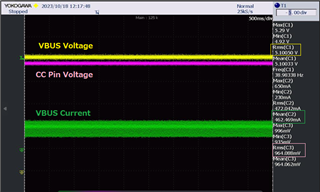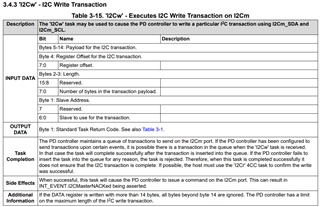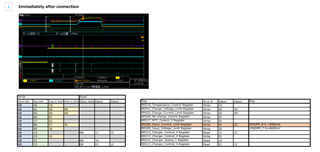Other Parts Discussed in Thread: BQ25792, USB-PD-CHG-EVM-01, TPS25751
Hi,
I received an inquiry regarding the negotiation issue between TPS25750 and BQ25792 from our customer. So, I would be grateful if you could give me some advice on the following.
When a 5V/1.5A source device was connected to TPS25750D with the prototype board, which was in the following status.
It seems to be recognizing charger current 1.5A as intended, but the actual USB supply current is only 0.5A.
- CC pin voltage was 0.964Vrms
- Cc1PinState of 0x69 TYPEC_STATE Register was 04h (1.5A Advertisement detected (Sink only))
The status of the charger IC BQ25792 shows as follow.
It seems that the information on the current value determined by TPS25750D through negotiation with a source device wasn’t correctly conveyed to BQ25792.
- VINDPM_7:0 of REG05_Input_Voltage_Limit Register was 4.7V
- IINDPM_8:0 of REG06_Input_Current_Limit Register was 500mA

In addition, some USB Type-C PD AC adapters and mobile batteries from other manufacturers with a power supply capacity of 15W to 30W couldn't be negotiated and the power supply would be cut off.
When checking the behavior, it seems that it was flowing a current higher than the one determined through negotiation with a source device.
For example, the negotiation result of TPS25750D was 9.00V/2.00A when using 18W(9V/2A) AC adapter.
However, the status of the charger IC BQ25792 shows as follow.
- VINDPM_7:0 of REG05_Input_Voltage_Limit Register was 4500mV
- IINDPM_8:0 of REG06_Input_Current_Limit Register was 2000mA or 3000mA
It is thought that it changes to 2A and 3A depending on the timing because negotiation is performed again after negotiation fails.
Could you please answer the following questions?
<Questions>
Q1.
Have you ever experienced such symptoms?
Q2.
Can TPS25750D support Type-C Current 1.5A?
Q3.
Is it the charger IC BQ25792 that controls the current so that it doesn't flow more current than the result of negotiation?
Q4.
How long does it take for BQ25792 REG06_Input_Current_Limit Register IINDPM_8:0 to change the current value setting from the negotiation result?
Q5.
What determines the timing at which BQ25792 flows current?
Additionally, I would like to share the detailed information (bin file, schematic, etc.) with you via an e-mail.
Please feel free to contact me if you have any questions.
Best regards,
Kato




